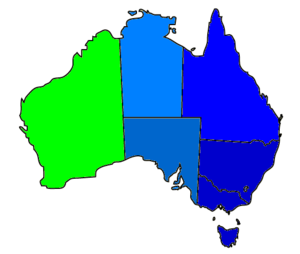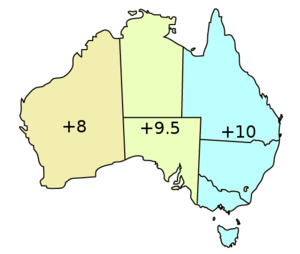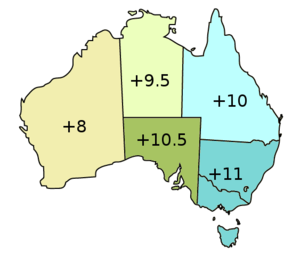- Time in Australia
-
Australia uses Standard time, i.e: the same well defined time for a region. The proper names of Australia's time zones are Australian Western Standard Time (WST), Australian Central Standard Time (ACST), and Australian Eastern Standard Time (AEST). In domestic contexts the leading "Australian" is often omitted, however the optional prefix 'A' is often used when abbreviating Australian Central Time and Australian Eastern Time to avoid ambiguity with the time zone abbreviations 'CST' and EST' referring to Central and Eastern time zones in the United States of America. Use of the abbreviation of 'AWST' to describe Australian Western Standard Time is a common misnomer. The three zones use three standard UTC offsets: western (UTC+08:00), central (UTC+09:30) and eastern (UTC+10:00).[1] Most Australian external territories also observe different time zones.
Standard time was introduced in the 1890s when all colonies adopted it. Before the switch to standard times, each local municipality was free to determine its own local time, called local mean time. Western Australia uses Western Standard Time, South Australia and the Northern Territory use Central Standard Time. All other states and the Australian Capital Territory use Eastern Standard Time.
New South Wales (NSW), the Australian Capital Territory (ACT), Victoria (Vic), South Australia (SA), and Tasmania (Tas) observe daylight saving time every year. Western Australia, Queensland and the Northern Territory do not observe daylight saving.
Though the states and territories have power to legislate time variations, the standard time within each is set in relation to Coordinated Universal Time (UTC), as determined by the International Bureau of Weights and Measures and maintained under section 8AA of the National Measurement Act 1960 of the Commonwealth.
Contents
Time zones
The standardization of time in Australia began in 1892, when surveyors from the Australian colonies gathered in Melbourne for the Intercolonial Conference of Surveyors. The delegates accepted the recommendation of the 1884 International Meridian Conference to adopt Greenwich Mean Time (GMT) as the basis for standard time, and in line with common practice in other parts of the world, devised a system of time zones with offsets in multiples of one hour from GMT. The colonies enacted legislation to this effect, which took effect in February 1895. Western Australia led GMT by 8 hours, South Australia by 9 hours, and Queensland, New South Wales, Victoria and Tasmania by 10 hours. The three time zones became known as Western, Central and Eastern Standard Time.
In May 1899, South Australia advanced Central Standard Time by thirty minutes, ignoring the generally common practice of adhering to one-hourly time zones. In doing so, the State also adopted a time meridian located outside its land mass in a further departure from international convention. Attempts to remedy these anomalies in 1986 and 1994 failed.
When the Northern Territory separated from South Australia, it retained Central Standard Time; likewise, when the Australian Capital Territory was created, it retained Eastern Standard Time.
Since then, the only major change has been the adoption of Central Standard Time in Broken Hill, New South Wales, and the use of GMT+10:30 on Lord Howe Island.
State legislation
In Victoria, South Australia, Tasmania and the ACT, the start and end dates of daylight-saving time are officially determined by proclamation, declaration or regulation made by the state governor or responsible minister. Such instruments may be valid for only the current year and so this section generally only refers to the legislation. In New South Wales and Western Australia, the start and end dates, if any, are fixed by legislation.
Western Standard Time (AWST) – UTC+08:00
- Western Australia – Standard Time Act 2005[2]
Central Standard Time (ACST)- UTC+09:30
- South Australia – Standard Time Act 2009[3] and the Daylight Saving Act 1971[4]
- Northern Territory – Standard Time Act 2005[5]
Eastern Standard Time (AEST) – UTC+10:00
- Queensland – Standard Time Act 1894[6]
- New South Wales – Standard Time Act 1987 No 149[7]
- Australian Capital Territory – Standard Time and Summer Time Act 1972[8]
- Victoria – Summer Time Act 1972[9]
- Tasmania – Standard Time Act 1895[10] and the Daylight Saving Act 2007 [11]
Anomalies
The town of Broken Hill (specified as Yancowinna County), in far-western New South Wales, follows South Australian time. Lord Howe Island in the Pacific Ocean uses UTC+10:30 during the winter months, but advances the clock by half an hour to UTC+11:00 in the summer, meaning it follows the rest of New South Wales for half of the year, but has its own timezone the rest of the time.
Residents of towns east of Caiguna on the Eyre Highway (including Eucla, Madura, Mundrabilla and Border Village) in the south-east corner of Western Australia near the South Australian border do not follow official Western Australian time. Instead, they use what is unofficially known as Central Western Standard Time, which is halfway between Western and Central time--UTC+8:45. The area maintained its fixed offset from UTC when daylight-saving time was introduced in South Australia. During Western Australia's trial of daylight-saving time from 2006–2009 the Central Western area also set its clocks ahead an hour during local summer. The total population of the area is estimated at just 200.[12]
The Indian Pacific train has its own time zone – a so-called "train time" when travelling between Kalgoorlie and Port Augusta which was UTC+9 hours during November 2005 when daylight-saving time was observed in the east. This was because of the 2 1⁄2 hour difference in times between South Australia and Western Australia.
External territories
Australia's external territories follow their own time zones.
Territory Standard DST Heard and McDonald Islands UTC+05:00 no DST Cocos (Keeling) Islands UTC+06:30 no DST Christmas Island CXT UTC+07:00 no DST Norfolk Island NFT UTC+11:30 no DST Australian Antarctic Territory – Mawson UTC+06:00 no DST Australian Antarctic Territory – Davis UTC+07:00 no DST Australian Antarctic Territory – Casey UTC+08:00 no DST Daylight saving time
The choice to use daylight saving time (DST) or not is a matter for the individual states and territories. However during World War I and World War II all states and territories observed the practice of daylight saving. In 1968 Tasmania became the first state since the war to practice daylight saving. In 1971, New South Wales, Victoria, Queensland, South Australia, and the Australian Capital Territory followed Tasmania by observing daylight saving. Western Australia and the Northern Territory did not. Queensland abandoned daylight saving time in 1972. Queensland and Western Australia have observed daylight saving over the past 40 years from time to time on trial bases.
New South Wales, the Australian Capital Territory, Victoria, Tasmania and South Australia observe DST every year. This has resulted in three time zones becoming five during the daylight-saving period. South Australia time becomes UTC+10:30, called Central Daylight Time (CDT), possibly with "Australia" prefixed (ACDT). The time in the southeastern states becomes UTC+11, using "Eastern" in the time zone name, with the abbreviations being EDT or AEDT.
Officially, the change to and from DST takes place at 2:00 am local standard time (which is 3:00 am DST) on the appropriate Sunday.
Of the states that observe DST, most began on the last Sunday in October, and ended on the last Sunday in March, until 2008. Tasmania, owing to its further southern latitude) began DST earlier, on the first Sunday in October, and ended on the first Sunday of April.
On 12 April 2007, New South Wales, Victoria, Tasmania and the Australian Capital Territory agreed to common starting and finishing dates for DST. From the 2008/09 period, the start of DST in these states and in South Australia commences on the first Sunday in October and ends on the first Sunday in April. Western Australia became the only state to observe daylight saving from the last Sunday in October to the last Sunday in March. Since 2009 Western Australia no longer observes daylight saving.[13]
Queensland (AEST UTC+10), Northern Territory (ACST UTC+9:30) and Western Australia (AWST UTC+8) do not observe DST.
State/Territory Start of DST End of DST Western Australia N/A Queensland Northern Territory South Australia first Sunday in October first Sunday in April[14] New South Wales Australian Capital Territory Victoria Tasmania Debate over daylight saving time – trials, referenda and politics
Queensland
Queensland has had a particularly involved debate over daylight-saving time, with public opinion geographically divided. A referendum on daylight saving, was held on 22 February 1992, following a three-year trial (1989/90 - 1991/92), and was defeated with a 54.5% 'no' vote.[15] The referendum result displayed a distinct trend - that public opinion on daylight saving in Queensland is geographically divided, with the ‘no’ vote strongest in the north and west regional districts, while the ‘yes’ vote was strongest in the state’s metropolitan south-east.[16]
Since the early 2000s, there have been a number of petitions submitted to Queensland Parliament, lobbying for the introduction of daylight-saving time or for another referendum to be held. A petition in 2006 was signed by 62,232 people.[17] In response to these petitions, then Queensland Premier Peter Beattie commissioned research to find out if daylight-saving time should be re-introduced into Queensland. Around this time, Premier Peter Beattie claimed that daylight-saving time in Queensland would increase the rate of skin cancer in the state, an unfounded claim for which there is no evidence according to the Queensland Cancer Fund.[18]
In October 2007, the completed government-commissioned research was presented to a newly sworn-in Premier Anna Bligh, who ruled out holding a new referendum, despite the report indicating 59% of Queensland residents and 69% of South East Queenslanders to be in favour of adopting daylight-saving time.[19]
In December 2008, the Daylight Saving for South East Queensland (DS4SEQ) political Party was officially registered, advocating the implementation of a dual-time zone arrangement for Daylight Saving in South East Queensland while the remainder of the state maintains standard time. The party contested the March 2009 Queensland State election with 32 candidates and received around one percent of the state-wide primary vote, equating to around 2.5% across the 32 electorates contested.[20]
In early 2010, the DS4SEQ political party approached independent Member, Peter Wellington, to introduce a private member's Bill for daylight saving.[21] As Wellington agreed with the principles of the DS4SEQ proposal, specifically the dual time zone arrangement, he drafted the Daylight Saving for South East Queensland Referendum Bill 2010 and tabled the Bill into Queensland Parliament on 14 April 2010.[22] Wellington has called for a referendum to be held at the next State election on the introduction of daylight saving into south-east Queensland under a dual-time zone arrangement.
In response to this Bill, Premier of Queensland, Anna Bligh, announced a community consultation process, which resulted in over 74,000 respondents participating, 64 percent of whom voted in favour of a trial and 63% were in favour of holding a referendum.[23] The decision announced by the Premier on 7 June 2010 was that her Government would not support the Bill, because regional Queenslanders were overwhelmingly opposed to daylight saving.[24] The Bill was defeated in Queensland Parliament on 15 June 2011.[25]
Western Australia
Western Australia has also had a particularly involved debate over daylight-saving time, with the issue being put to a referendum four times: in 1975, 1984, 1992, and 2009. All were defeated. Voters returned a "no" vote of 54.57% in 2009, the highest in all four referendums. Each referendum followed a trial period during which the state observed daylight saving time. The first three followed a one-year trial, while the 2006 Western Australian Daylight Saving Bill (No. 2) 2006 instituted a daylight-saving trial beginning on 3 December 2006 and lasting for three years.[26] The referendum was defeated in 2009.
Special events
In 2000, all eastern jurisdictions that normally observe daylight-saving time — New South Wales, Victoria, the Australian Capital Territory and Tasmania — started daylight-saving time early, due to the 2000 Summer Olympics in Sydney. These jurisdictions changed on 27 August 2000. South Australia did not change until the regular time, which that year was on 29 October.
In 2006, all states that followed daylight-saving time (the above listed states plus South Australia) delayed the return to their respective Standard Times by a week, due to the 2006 Commonwealth Games in Melbourne. Daylight-saving time ended on 2 April 2006.
Accuracy and standards
Although Australia has maintained a version of the Coordinated Universal Time (UTC) atomic time scale since the 1990s, Greenwich Mean Time (GMT) remained the formal basis for the standard times of all states until 2005. In November 2004, the state and territory attorneys-general endorsed a proposal from the Australian National Measurement Institute to adopt UTC as the standard of all Australian standard times, thereby eliminating the effects of slight variations in the Earth's rotation rate that are inherent to mean solar time. All states have adopted the UTC standard, commencing from 1 September 2005.
National times
However, there are situations where a nation-wide time operates. In the case of business activities a national time, in effect, operates. For example, a prospectus for the issue of shares in a company would usually set out the closing time for offers at some location (e.g. Sydney) as the time when offers must be received, irrespective of the source of the offer. Similarly, tenders usually set out the time at a particular location by which they must be received to be considered. Another example is the Australian Stock Exchange which, in effect, operates on AEST.
On the other hand, Commonwealth legislation yields to state-regulated standard times in many diverse situations. It yields, for example, in setting normal working times of Commonwealth employees, recognition of public holidays, etc. Significantly, it also relies on local time for federal elections, so that polling times in Western Australia close, in effect, two or three hours after those in the eastern states. Similarly, documents to be filed in a Federal Court may be filed based on local time; with the effect that if there was a failure to lodge a document on time in an eastern state, the document may still be lodged (within two hours) in Western Australia.
See also
- List of time zones
- Daylight saving time
- Peter Wellington
- Daylight Saving for South East Queensland
- Daylight Saving for South East Queensland Referendum Act 2010
- Queensland daylight savings referendum, 1992
- Daylight saving time around the world
Notes
- ^ "Official Australian government website". australia.gov.au. http://australia.gov.au/about-australia/our-country/time. Retrieved 2010-06-25.
- ^ "slp.wa.gov". http://www.slp.wa.gov.au/statutes/swans.nsf/5d62daee56e9e4b348256ebd0012c422/584023b76077504a482570bb002576e3/$FILE/Standard%20Time%20Act%202005.PDF. Retrieved 2011-09-20.
- ^ Australia. "South Australian Legislation". Legislation.sa.gov.au. http://www.legislation.sa.gov.au/LZ/C/A/Standard%20Time%20Act%202009.aspx. Retrieved 2010-06-25.
- ^ Australia. "South Australian Legislation". Legislation.sa.gov.au. http://www.legislation.sa.gov.au/LZ/C/A/DAYLIGHT%20SAVING%20ACT%201971.aspx. Retrieved 2010-06-25.
- ^ "STANDARD TIME ACT 2005". Notes.nt.gov.au. http://notes.nt.gov.au/dcm/legislat/legislat.nsf/d989974724db65b1482561cf0017cbd2/5e76fcb5843998606925706f0023b1da?OpenDocument. Retrieved 2010-06-25.
- ^ "legislation.qld.gov". http://www.legislation.qld.gov.au/LEGISLTN/CURRENT/S/StandTimeA1894.pdf. Retrieved 2011-09-20.
- ^ "Standard Time Act 1987 No 149". Legislation.nsw.gov.au. http://www.legislation.nsw.gov.au/viewtop/inforce/act+149+1987+FIRST+0+N/?autouery=(FragmentSGML%3D((%22Standard%22%20AND%20%22Time%22%20AND%20%22Act%22%20AND%201987%20AND%20%22No%22%20AND%20149)))%20AND%20((RecordType%3D%22ACTFRAG%22%20and%20Repealed%3D%22N%22)%20OR%20(RecordType%3D%22SRFRAG%22%20and%20Repealed%3D%22N%22))&dq=Document%20Types%3D%22Acts,%20Regs%22,%20All%20Words%3D%22Standard%20Time%20Act%201987%20No%20149%22,%20Search%20In%3D%22Text%22&fullquery=(((%22Standard%22%20AND%20%22Time%22%20AND%20%22Act%22%20AND%201987%20AND%20%22No%22%20AND%20149. Retrieved 2010-06-25.
- ^ "ACT legislation register – Standard Time and Summer Time Act 1972 – main page". Legislation.act.gov.au. http://www.legislation.act.gov.au/a/1972-34/default.asp. Retrieved 2010-06-25.
- ^ [1][dead link]
- ^ [2][dead link]
- ^ "Legislation View Page". Thelaw.tas.gov.au. http://www.thelaw.tas.gov.au/tocview/index.w3p;cond=ALL;doc_id=77%2B%2B2007%2BAT%40EN%2B20090415050000;histon=;prompt=;rec=;term=. Retrieved 2010-06-25.
- ^ "Border sign". Confluence.org. http://www.confluence.org/photo.php?visitid=10280&pic=7. Retrieved 2010-06-25.
- ^ "Daylight Saving Time – Implementation". Bom.gov.au. http://www.bom.gov.au/climate/averages/tables/dst_times.shtml. Retrieved 2010-06-25.
- ^ "Daylight Saving in Victoria (Victoria Online)". Vic.gov.au. 2006-09-21. http://www.vic.gov.au/daylight-saving-in-victoria.html. Retrieved 2010-06-25.
- ^ "1992 Queensland Daylight Saving Referendum" (PDF). http://www.ecq.qld.gov.au/WorkArea/linkit.aspx?LinkIdentifier=id&ItemID=74. Retrieved 2010-07-25.
- ^ Queensland Parliamentary Library; Research Brief No 2010/22 - Mary Westcott (July 2010). "1992 Daylight Saving in Queensland" (PDF). pp. 15, 19. http://www.parliament.qld.gov.au/view/publications/documents/research/ResearchBriefs/2010/RBR201022.pdf. Retrieved 2011-01-29.
- ^ "Daylight Saving Petition". http://www.parliament.qld.gov.au/view/EPetitions_QLD/ClosedEPetition.aspx?PetNum=553&lIndex=-1. Retrieved 2010-07-25.
- ^ "Daylight saving cancer claim disputed". The Sydney Morning Herald (Fairfax Media). 2006-10-24. http://www.smh.com.au/news/National/Daylight-saving-cancer-claim-disputed/24/10/2006/1161455713865.html. Retrieved 2007-07-07.[dead link]
- ^ "Queensland Government-commissioned Daylight Saving Research" (PDF). http://www.premiers.qld.gov.au/publications/categories/reports/assets/exec-summary.pdf. Retrieved 2010-07-25.
- ^ "Total Candidates Nominated for Election by Party – 2009 State Election". Electoral Commission of Queensland (ECQ). http://www.ecq.qld.gov.au/elections/state/state2009/results/summary.html#16. Retrieved 2010-06-19.
- ^ "The Political Mouse that Roared". 16 April 2010. http://www.brisbanetimes.com.au/queensland/the-political-mouse-that-roared-20100414-sdzv.html. Retrieved 2010-06-19.
- ^ "Daylight Saving for South East Queensland Referendum Bill 2010". 14 April 2010. http://www.legislation.qld.gov.au/Bills/53PDF/2010/DaySavSEQRB10_P.pdf. Retrieved 2010-07-25.
- ^ "Queensland Government Daylight Saving for South East Queensland survey". http://www.getinvolved.qld.gov.au/your-say/daylight-saving-results.html. Retrieved 2010-07-25.
- ^ "Queensland Government Daylight Saving for South East Queensland decision". http://www.cabinet.qld.gov.au/mms/StatementDisplaySingle.aspx?id=70063. Retrieved 2010-07-25.
- ^ "Daylight saving silence 'deafening'". 16 June 2011. http://www.brisbanetimes.com.au/queensland/daylight-saving-silence-deafening-20110616-1g4k6.html. Retrieved 2011-06-19.
- ^ "Microsoft Word - D01 Daylight Saving Bill _No. 2_ 2006 _175-1B_.doc" (PDF). http://www.parliament.wa.gov.au/parliament/bills.nsf/9A1B183144403DA54825721200088DF1/$File/Bill175-1B.pdf. Retrieved 2010-06-25.
References
- The Australian National Time System National Standards Commission Leaflet No. 8, January 2003. Linked via Wayback machine
- NSW Legislative Council Hansard, 2 March 2005
- Daylight Saving Petitions
- Daylight Saving Time History of daylight saving time implementation dates at the Bureau of Meteorology website.
External links
- Information on time zones from official Government web site
- Daylight Saving for South East Queensland political party Official DS4SEQ website
Time in Oceania Sovereign states - Australia
- East Timor (Timor-Leste)
- Fiji
- Indonesia
- Kiribati
- Marshall Islands
- Federated States of Micronesia
- Nauru
- New Zealand
- Palau
- Papua New Guinea
- Samoa
- Solomon Islands
- Tonga
- Tuvalu
- Vanuatu
Dependencies and
other territories- American Samoa
- Christmas Island
- Cocos (Keeling) Islands
- Cook Islands
- Easter Island
- French Polynesia
- Guam
- Hawaii
- New Caledonia
- Niue
- Norfolk Island
- Northern Mariana Islands
- Pitcairn Islands
- Tokelau
- Wallis and Futuna
Categories:- Time in Australia
- Science and technology in Australia
- Australian standards
Wikimedia Foundation. 2010.



